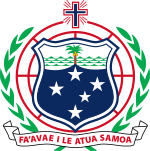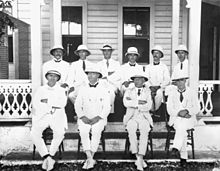Legislative Assembly of Samoa
Legislative Assembly of Samoa Fono Aoao Faitulafono o Samoa | |
|---|---|
| 17th Parliament | |
 | |
| Type | |
| Type | Unicameral |
| Leadership | |
Speaker | |
Deputy Speaker | |
Deputy Prime Minister | |
| Structure | |
| Seats | 51 |
 | |
Political groups |
|
Length of term | Up to 5 years |
| Elections | |
Voting system | First-past-the-post |
Last election | 9 April 2021 |
Next election | On or before April 2026 |
| Meeting place | |
| Maota, Tiafau, Apia[2] | |
| Website | |
| www | |
The Legislative Assembly (Samoan: Fono Aoao Faitulafono a Samoa), also known as Parliament of Samoa (Samoan: Palemene o Samoa), is the national legislature of Samoa, seated at Apia, where the country's central administration is situated. Samoan Parliament is composed of two parts: the O le Ao o le Malo (head of state) and the Legislative Assembly.
In the Samoan language, the Legislative Assembly of Samoa is sometimes referred to as the Samoan Fono while the government of the country is referred to as the Malo. The word fono is a Samoan and Polynesian term for councils or meetings great and small and applies to national assemblies and legislatures, as well as local village councils.
The modern government of Samoa exists on a national level alongside the country's fa'amatai indigenous chiefly system of governance and social organisation.[3] In his or her own right, the O le Ao o le Malo can summon and call together the Legislative Assembly, and can prorogue or dissolve Parliament, in order to either end a parliamentary session or call a general election on behalf of the Prime Minister of Samoa.
History[]
 |
|---|
| Constitution |
|

The Samoan Fono is descended from the Western Samoan Legislative Assembly established under New Zealand rule in the early 1900s. On the country's political independence in 1962, the 5th Legislative Assembly became the .[4]
Powers and procedures[]
The Samoan Constitution provides the Legislative Assembly to make laws for the whole or any part of Samoa and laws having effect outside as well as within Samoa. Any Member of Parliament may introduce any bill or propose any motion for debate in the Assembly or present any petition to the Assembly, and the same shall be considered and disposed of under the provisions of the Standing Orders.
Members of Parliament posessess parliamentary privilege and immunities.
The Legislative Assembly can be dissolved or prorogue by the O le Ao o le Malo, with the advice of the Prime Minister.
Members of Parliament[]
Prior to a 2019 constitutional amendment, the Samoan Fono had 49 Members of Parliament. These were elected in six two-seat and 35 single-seat constituencies. Of these 49 seats, 47 were legally reserved for traditional heads of families (matai) and two for special constituencies: These two seats were first reserved for Samoan citizens descended from non-Samoans (so-called 'individual constituencies') and elected on a non-territorial basis until the 2015 constitutional amendment after which these were replaced with specific 'urban constituencies'.[5] These 'urban constituencies' were only in place for the 2016 general election and were then abolished by the 2019 amendment ahead of the next general election. Following this amendment, each electoral constituency elects one member, totalling 51 members of parliament.[6][7]
An extra Member of Parliament was added after the 2016 election in order to meet the quota of 10% female MPs.[8]
Members of Parliament in Samoa are directly elected by universal suffrage, and serve a five-year term.
Current composition[]

| |||||
| Affiliation | Leader in Parliament | Status | Seats | ||
|---|---|---|---|---|---|
| 2021 election | Current | ||||
| Faatuatua i le Atua Samoa ua Tasi | Fiamē Naomi Mata'afa | Majority | 25 | 26 | |
| Human Rights Protection Party | Tuila'epa Sa'ilele Malielegaoi | Opposition | 25 | 18 | |
| Independent | N/A | Crossbench | 1 | 0 | |
| Vacant | N/A | Vacant | 0 | 7 | |
| Total | 51 | 51 | |||
Head of State[]
The ceremonial Head of State or O le Ao o le Malo is elected for a five-year term by the Fono. He or she is limited to a maximum of 2 terms.
Elections[]
Elections are held under a simple plurality system. Samoan electors are divided into six two-seat and 35 single-seat constituencies. In addition, two seats are reserved for "individual voters", non-indigenous citizens who may not hold a chiefly title or any customary interest in Samoan land.
Electors must be Samoan citizens and aged over 21.[9] Candidates must be qualified as electors, and in addition those for territorial seats must hold a matai title.[10]
Last election results[]
 | |||||
| Party | Votes | % | Seats | +/– | |
|---|---|---|---|---|---|
| Human Rights Protection Party | 49,237 | 55.38 | 25 | –10 | |
| Faʻatuatua i le Atua Samoa ua Tasi | 32,510 | 36.57 | 25 | New | |
| Tautua Samoa Party | 2,900 | 3.26 | 0 | –2 | |
| Samoa First Party | 207 | 0.23 | 0 | New | |
| Sovereign Independent Samoa Party | 30 | 0.03 | 0 | New | |
| Independents | 4,025 | 4.53 | 1 | –12 | |
| Total | 88,909 | 100.00 | 51 | +1 | |
| Valid votes | 88,909 | 99.32 | |||
| Invalid/blank votes | 605 | 0.68 | |||
| Total votes | 89,514 | 100.00 | |||
| Registered voters/turnout | 128,848 | 69.47 | |||
| Source: Government of Samoa, Seat counts, Registered voters; Candidate affiliations of all except Vaa o Fonoti, Anoamaa 1 and Aleipata Itupa i Luga | |||||
Terms of the Fono[]
The Fono is currently not in session, having not been convened since the 2021 Samoan general election was held, due to the current constitutional crisis.
| Term | Elected in | Government |
|---|---|---|
| 1948 election | No parties | |
| No parties | ||
| No parties | ||
| 1957 election | No parties | |
| 1961 election | No parties | |
| 1964 election | No parties | |
| 1967 election | No parties | |
| 1970 election | No parties | |
| 1973 election | No parties | |
| 1976 election | No parties | |
| 1979 election | No parties | |
| 1982 election | Human Rights Protection Party | |
| 1985 election | Human Rights Protection Party / Christian Democratic Party (Samoa) | |
| 1988 election | Human Rights Protection Party | |
| 1991 election | Human Rights Protection Party | |
| 1996 election | Human Rights Protection Party | |
| 2001 election | Human Rights Protection Party | |
| 14th Parliament | 2006 election | Human Rights Protection Party |
| 15th Parliament | 2011 election | Human Rights Protection Party |
| 16th Parliament | 2016 election | Human Rights Protection Party |
| 17th Parliament | 2021 election | Faʻatuatua i le Atua Samoa ua Tasi |
Building[]
The Fono is housed in a beehive shaped building based on the traditional Samoan fale.
See also[]
- Electoral Constituencies of Samoa
- List of Speakers of the Legislative Assembly of Samoa
- Politics of Samoa
- List of legislatures by country
Notes[]
References[]
- ^ "Tuilaepa accepts defeat, opposition leadership". Samoa Observer. 27 July 2021. Retrieved 27 July 2021.
- ^ http://www.palemene.ws/new/wp-content/uploads//Infosheet/Infosheet-01-Legislative-Assembly-of-Samoa.pdf
- ^ Fana'afi Le Tagaloa, Aiono (1986). Western Samoa the Sacred Covenant. Land rights of Pacific women. University of the South Pacific;Institute of Pacific Studies. p. 103. ISBN 982-02-0012-1. Retrieved 2 March 2010.
- ^ Parliament of Samoa: general information Archived June 24, 2007, at the Wayback Machine
- ^ "Constitution Amendment 2015 (English)" (PDF). Parliament of Samoa. 3 June 2015. Archived (PDF) from the original on 22 May 2021. Retrieved 22 May 2021.
- ^ "Constitution Amendment Act (No. 3)" (PDF). Parliament of Samoa. 31 January 2019. Archived (PDF) from the original on 22 May 2021. Retrieved 22 May 2021.
- ^ "Samoa to bring about changes to parliament". RNZ. 2019-01-30. Retrieved 2021-05-22.
- ^ "Fa'aulusau Rosa Duffy-Stowers secures 5th Parliamentary seat for women". Talamua Online. 11 March 2016. Archived from the original on 22 March 2016. Retrieved 16 March 2016.
- ^ Electoral Act 1963, s16 Archived March 6, 2009, at the Wayback Machine
- ^ Electoral Act 1963, s5 Archived October 2, 2006, at the Wayback Machine
External links[]
- 1962 establishments in Western Samoa
- Parliaments by country
- Government of Samoa
- National legislatures
- Politics of Samoa
- Political organisations based in Samoa
- Unicameral legislatures